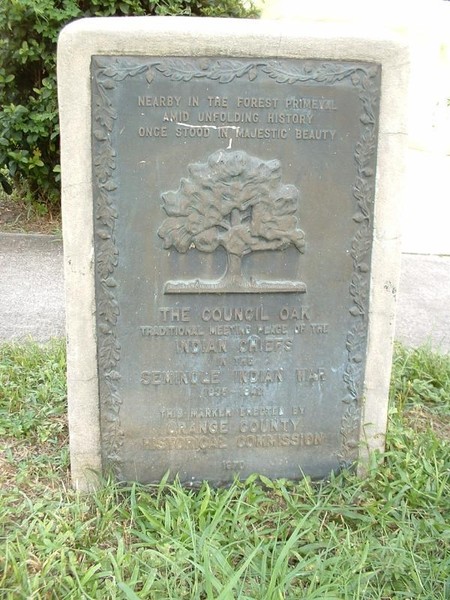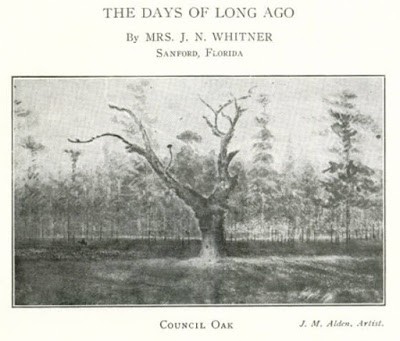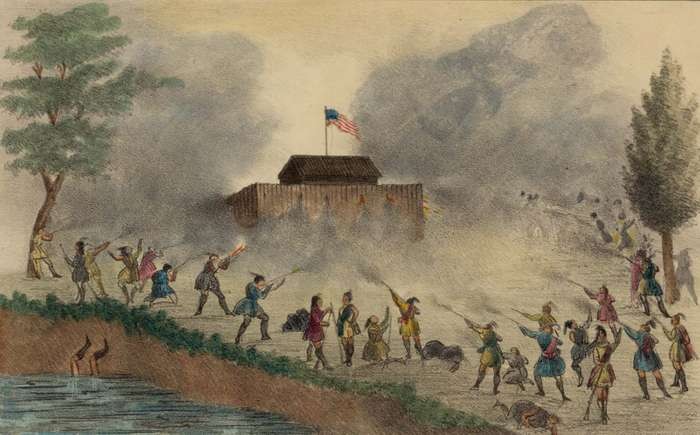The Council Oak
Introduction
Text-to-speech Audio
Images
A marker points out the location of the Council Oak, the spot where the Seminole chiefs held their meetings.

From the 1915 book, Early Settlers of Orange County by C. E. Howard

The site of the Fort was again utilized by the government when the Navy created the Underwater Sound Reference Laboratory during WWII to take advantage of the great depth of Lake Gem Mary.

Seminoles attacking a fort, possibly on the Withlacoochee River, in December 1835 during the Second Seminole War.

Backstory and Context
Text-to-speech Audio
The Council Oak was the traditional meeting place of Native American chiefs during the Second Seminole War (1835-1842). It was said to be the largest live oak in all of central and south Florida. The Council Oak later was struck by lightning in the late 1800s. A marker was placed at the approximated site of the legendary tree on Fern Creek Avenue in Orlando, Florida during the 1970s by the Orange County Historical Commission.
In Clarence E. Howard's novel called Early History of Orange County, a resident, Annie Whitner wrote of the “bleached trunk and bare wide-spread branches of an immense dead live-oak, still standing. It is said that red men and white men met here to hold a council. The Council Oak stands, her white arms held aloft, a silent protest against the injustice of war, a ghostly presence lamenting her children, a memorial of them, which time, nor storm has expelled in all the years since then.”
Author of Orlando in the Long, Long Ago, Kena Fries, wrote about the Council Oak: “On the west side of Pine Loch Lake, where the old trail worked its way thru the pine woods, there once stood an immense live oak, said in its glory to have been the largest live oak in all of central and south Florida. It was known as ‘council oak’, the gathering place of the Seminole warriors.” It was said that an ancient Indian trail became a military route leading from Lake Monroe to Fort Gatlin. The Council Oak was located on the trail.
Sources
The Council Oak, Waymarking. August 1st 2008. Accessed January 18th 2020. https://www.waymarking.com/waymarks/WM4B8Z.
This website highlights different Florida Historical Markers. Specifically, it shows The Council Oak marker on the side of a road in Orlando Florida. This website tells us that the marker was placed by the Orange County Historical Commission in 1970. This marker represents where the actual oak tree was before it struck by lightning and burned down in the late 1800s.
Dickinson, Joy Wallace. GIANT COUNCIL OAK IS GONE, BUT ITS PRESENCE IS FELT, Orlando Sentinel . July 6th 2003. Accessed January 19th 2020. https://www.orlandosentinel.com/news/os-xpm-2003-07-06-0307040093-story.html.
This article talks about the Council Oak and how it had used to be the largest Live Oak and all of Central and South Florida. The article also goes into great detail about how sometime in the 1880s the tree was struck down by lightning. The article talks about how no records exist of a tribal council at that spot but it describes that either the Seminoles or early native people use the tree as a meeting spot.
Weiser-Alexander, Kathy. Fort Gatlin, Florida, Legends of America. February 20th 2020. Accessed February 15th 2020. https://www.legendsofamerica.com/fort-gatlin-florida/.
This website first describes Fort Gatlin, Florida which was established by the United States
Army during the Second Seminole War. The site of the fort was chosen because The area was
often by Indians led by Seminole Chief King Philip. This website also highlights the Council Oak because it was the traditional meeting place of chiefs during the Second Seminole War (1835 - 1842). It says that a historical marker has been placed just in sight of the legendary tree.
Kilby, Rick. Finding Fort Gatlin, Old Florida. March 24th 2009. Accessed March 30th 2020. http://studiohourglass.blogspot.com/2009/03/finding-fort-gatlin.html.
The author of the article about Fort Gatlin talks about how the city is filled with historical landmarks from The Second Seminole War. The article goes over how Fort Gatlin was created at a strategic point overlooking three Orlando lakes: Lake Gem Mary, Lake Jennie Jewel, and Lake Gatlin. The site of Fort Gatlin was again utilized by the government when the Navy created the Underwater Sound Reference Laboratory during WWII to take advantage of the great depth of Lake Gem Mary.
The Seminole Wars, Florida Department of State. Accessed March 30th 2020. https://dos.myflorida.com/florida-facts/florida-history/seminole-history/the-seminole-wars/.
This website goes over the First, Second and Third Seminole Wars. The U.S. Army attacked the Indian tribe in the First Seminole War (1817-1818), which took place in Florida and southern Georgia. During The Second Seminole War, the United States spent more than $20 million fighting the Seminoles. And The Third Seminole War broke out in 1855 when conflicts erupted between whites and some Seminoles who remained in Florida. There were constant military patrols and rewards for the capture of Indians reduced the Seminole population to about 200 when the Third Seminole War ended in 1858.
Cronin, Richard Lee. THE ALDEN'S OF ORLANDO'S PINELOCH:, Citrusland FL. March 13th 2017. Accessed April 20th 2020. https://citruslandfl.blogspot.com/2017/03/the-aldens-of-orlandos-pineloch.html.
This website goes over lots of historical information about central Florida and eye witness accounts of the burned down Council Oak during the 1900s.
The Council Oak, Waymarking. August 1st 2008. Accessed January 18th 2020. https://www.waymarking.com/waymarks/WM4B8Z.
Cronin, Richard Lee. THE ALDEN'S OF ORLANDO'S PINELOCH:, Citrusland FL. March 13th 2017. Accessed April 20th 2020. https://citruslandfl.blogspot.com/2017/03/the-aldens-of-orlandos-pineloch.html.
Kilby, Rick. Finding Fort Gatlin, Old Florida. March 24th 2009. Accessed March 30th 2020. http://studiohourglass.blogspot.com/2009/03/finding-fort-gatlin.html.
Bauer, Patricia. Second Seminole War, ENCYCLOPÆDIA BRITANNICA. December 21st 2019. Accessed April 20th 2020. https://www.britannica.com/event/Second-Seminole-War.
